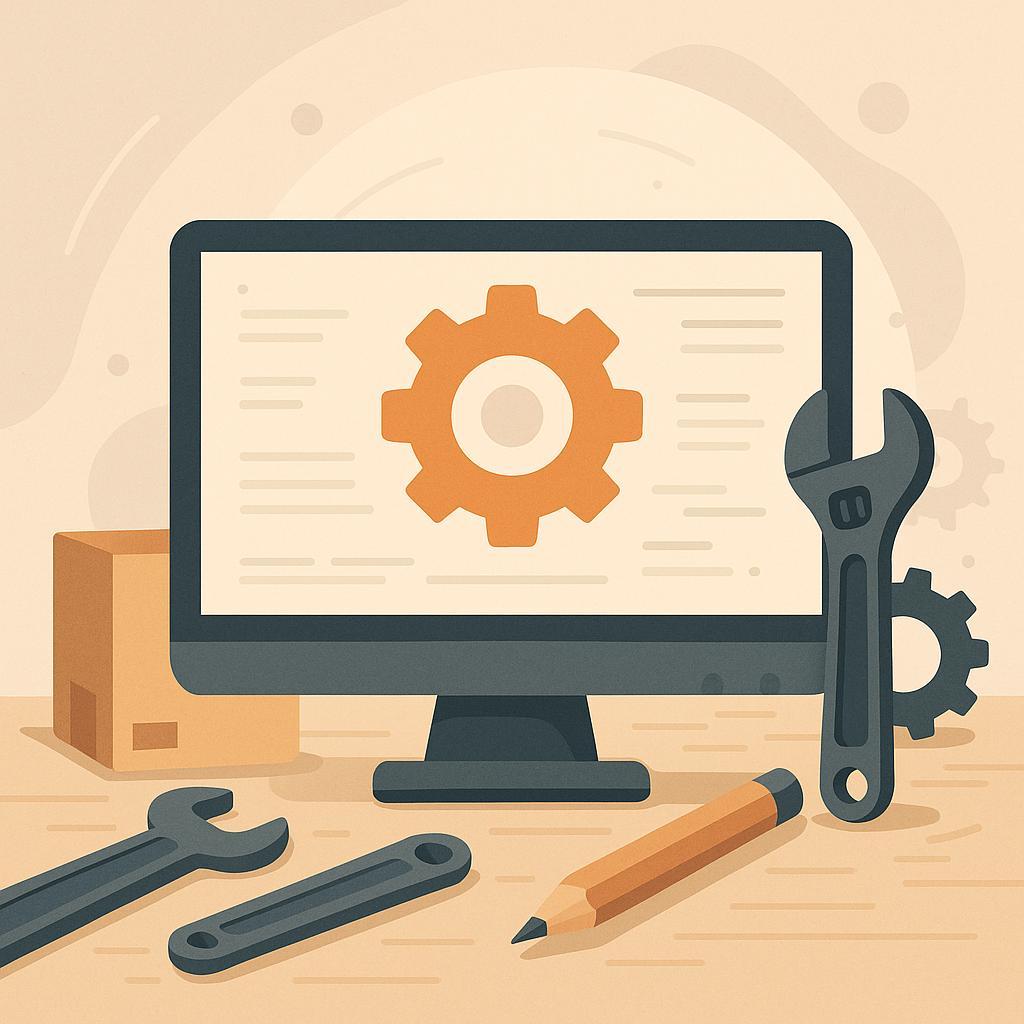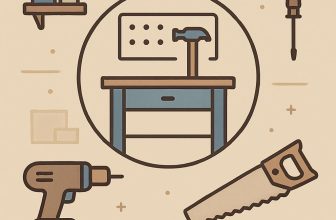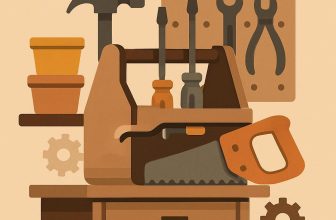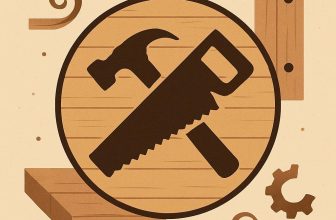
Your first cut starts long before the blade touches wood-the real work happens in how you set up your shop.For woodworking enthusiasts, a thoughtful setup is safety, accuracy, and momentum all working in harmony. This guide helps you establish a practical, scalable foundation-from space layout and power to dust control, storage, and safety-so your tools perform at their best. Learn a beginner-friendly setup you can trust: a simple workflow, essential gear, maintenance routines, and how to tweak the plan as your ideas grow.
Building a Functional Workspace for the Beginner's Workshop
Design your beginner's workshop around a few core principles that keep every project moving smoothly. A functional space uses clearly defined zones for raw material intake, preparation, assembly, and finishing. Place your most-used tools within arm's reach, and arrange aisles so you can move from one station to another without crossing paths. Aim for a triangle workflow that minimizes back-and-forth and reduces clutter,with a dedicated spot for waste and offcuts to keep the bench clean.
Invest in a solid workbench that can handle the tasks you plan to tackle, plus sturdy lighting and reliable dust management. A height-adjustable bench reduces strain, while high-CRi LED lighting improves accuracy on fine cuts. Provide abundant, organized storage: wall-mounted racks for frequently used clamps, labelled drawers for small parts, and a shelving system for consumables. Safety gear-eye protection, hearing protection, respirators-should be easy to grab, not buried in a bin. For power, install a few accessible outlets and cord management so cords stay off the floor and away from blades.
tailor the space to your projects and budget by testing layouts before committing. Measure your target equipment footprints, route cables under the bench, and create a quick-clean routine to keep dust from migrating.Keep a simple,rotating checklist of weekly maintenance tasks (wipe down surfaces,empty bin,re-index tools) so the workspace stays predictable and inviting. A small, dedicated cooling or ventilation step can dramatically improve comfort during finishing stages, turning long sessions into a steady, productive rhythm.
| Item | Purpose | Suggested Budget |
|---|---|---|
| Workbench | Flat, durable surface for tasks | $100-$400 |
| Lighting | Even, high-contrast visibility | $50-$150 |
| storage & Association | Keeps tools accessible and labeled | $60-$200 |
| Dust Control | Helps keep air clean and surfaces clear | $50-$250 |
| Electrical & cables | Safe power access and cable management | $20-$60 |
| Safety Gear | Eye/ear protection, respirators | $15-$60 |
Build Your Dream Workshop on a Budget →
Choosing Tools and Equipment for a Strong Foundation
Choosing tools is about building a foundation that fits your space and projects. Start with durable basics you can rely on every session, and prioritize ergonomics, reliability, and compatibility with future upgrades. A well-balanced starter set reduces frustration and keeps you in the flow, turning setup time into productive practice rather than hunting for the right bit or a missing hex key.
Think through your typical projects and map them to four core tool families: hand tools for precise control,measuring and marking for accuracy,power tools for speed,and safety and organization to protect you and your workspace. If you often work in tight spaces, size and weight matter as much as capability, so choose compact, reversible, or cordless options where possible.This planning helps you avoid accidentally buying tools you'll rarely use.
Budget-smart strategies pay off here. Start with the essentials, then grow your kit in stages. Consider used or refurbished options from reputable sources, weigh the cost of rental for occasional heavy-duty tasks, and look for tools with solid warranties and interchangeable batteries. A simple rule: buy once, buy right, and don't chase the trend-favor proven, repairable designs over flashy features that won't stand the test of time.
design a dedicated, tidy workspace that supports your workflow. A sturdy workbench, proper lighting, and a logical layout cut idle time and reduce accidents. Invest in basic safety gear-eye and ear protection, a dust mask if you're sanding, and a first-aid kit-and create a small parts bin system to keep drill bits, blades, and fasteners accessible but organized. With thes foundations in place, your workshop becomes a launching pad for consistent practice and tangible progress.
| Category | starter Picks | Why it matters |
|---|---|---|
| Hand tools | Hammer, screwdrivers, pliers | Foundation for precision and control |
| Measuring & marking | Tape measure, square, marking knife | Ensures accuracy and repeatability |
| Power tools (starter) | Cordless drill, compact sander | Boosts speed and capability |
| Safety & organization | Safety glasses, hearing protection, toolbox | Protects you and keeps space efficient |
Build Your Dream Workshop on a Budget →
Mastering Power, Connectivity, and Cable Management
Efficient power planning keeps your workshop humming without tripping breakers or tangled cords. Start by mapping your workspace: note where outlets live,which tools you rely on,and how long they run in a typical session. Choose a high-quality surge protector or power strip with a built-in circuit breaker, and avoid daisy-chaining by connecting multiple strips in a single chain to a single outlet. When in doubt, place heavy-load devices on dedicated outlets or circuits, and label each strip and outlet with a quick description (for example, “Table Saw” or “Soldering Station”) to speed setup and troubleshooting.
Connectivity that stays reliable is the backbone of a focused build session. Place your router where it can reach the entire workspace, and run a primary Ethernet line to a small switch so critical gear stays wired: PC, printer, and any network storage. Use Wi-Fi for tablets and phones,but favor wired connections for demanding tasks. If wireless is necessary across the shop, add a mesh node or a single access point to fill gaps, then route and label cables from wall to hub to keep the floor clear. Below is a quick reference on common Ethernet cable categories to help you pick the right tool for the job.
| Cable Type | Typical Speed | Best For |
| Cat5e | 1 Gbps | Basic networking, simple desks |
| Cat6 | Up to 10 Gbps (short runs) | Most home/workshop setups |
| Cat6a | 10 Gbps reliably | Higher bandwidth, less interference |
| Cat7 | 10 Gbps+ with shielding | Premium, shielded environments |
Cable management transforms a cluttered desk into a calm, productive zone. Start with a simple route map: draw lines from outlets to devices and keep data and power runs separate wherever possible. Use reusable Velcro straps rather than single-use zip ties, and install a few under-desk trays, raceways, or cable channels to keep cords off the floor. Color-code cables by type (for example, red for power, blue for data) and leave a little slack at each bend to accommodate movement or upgrades. label both ends of each run so you can identify a cable in seconds when you rearrange gear or troubleshoot a fault.
Maintenance and vigilance are the secret ingredients of lasting organization. Schedule a quarterly audit of your power and data runs: remove dust,check for wear or fraying,and verify that no cables are snagging doors or chair legs. Update your cable map as equipment moves, and re-seat connections if you notice any looseness. keep spare lengths of common cables on hand, and create a living checklist that you or a student can follow to preserve a tidy setup as your workshop grows.
Build Your Dream Workshop on a Budget →
Optimizing Lighting and Sound to Enhance Focus
lighting is a quiet ally in focus. Start by mapping how daylight travels through your space and position your desk to catch it without glare on screens. A neutral white around 4000-5000K keeps you alert without the harsh chill of blue-tinted light, and a brightness target of roughly 300-600 lux at the desk helps reduce eye strain during long sessions. If daylight shifts with the day,keep a dimmable LED lamp at hand so you can tune intensity without a jarring tonal jump. A practical tip: aim light from the side of your work zone, so shadows land on the surface rather than your face or eyes.
Three-layer lighting for focus provides depth,reduces glare,and keeps eyes comfortable as you work.
- Ambient layer: an overhead fixture with a diffuser to create even illumination and avoid luminous hotspots on the screen.
- Task layer: a portable desk lamp with an adjustable beam; set the color temperature to 4000-5000K and place it so the light sweeps your workspace without reflecting in the monitor.
- Control layer: use blinds or a dimmer to tailor the overall brightness, and consider a bias light behind the monitor to reduce contrast when you look away.
Sound also shapes focus. Start with soft surfaces-thick curtains,a rug,and a padded chair-to dampen reflections and minimize distracting echoes. For a microphone and recording setup, position the mic about 20-40 cm from your mouth and at a slight angle to avoid plosive pops; a cardioid pattern helps isolate your voice from room noise. On a budget, mount a couple of affordable acoustic panels on problem walls and add furniture cushions to absorb sound. If room treatment isn't possible, a low-level white-noise or ambient track can mask sudden interruptions; test by recording a short cue and listening for clarity.
| Element | Recommended Setup | Notes |
|---|---|---|
| Microphone | Cardioid USB mic; 20-40 cm from mouth | Minimizes room noise |
| Acoustic Treatment | 2-4 panels on problem walls; soft furnishings | Reduces reflections |
| Ambient Noise | Low-level white noise or gentle ambience | Masks abrupt sounds |
Practical setup routine to keep focus steady includes quick checks and simple tweaks:
- Do a 2-minute brightness and color-timing check each morning; adjust to keep balance between screen whites and surrounding light.
- Record a brief test clip to hear how your voice sounds with current room acoustics, and reposition if needed.
- Maintain a simple log of lamp positions, panel placements, and any environmental changes (temperature, humidity) that affect comfort.
Build Your Dream Workshop on a Budget →
Organizing Storage and Material Flow for Everyday Tasks
Begin by mapping a simple footprint for everyday tasks. Designate a nearby workbench for the daily grind, a dedicated tool wall or pegboard, and vertical storage for consumables. The aim is to minimize search time and keep the most-used items within arm's reach. Use clear containers and transparent bins so you can see contents at a glance, and label drawers and boxes so nothing hides in the back. A clean,intentional layout lowers interruptions and makes every session feel purposeful.
| Zone | Purpose | Typical Items | Accessibility Tips |
|---|---|---|---|
| Workbench Zone | Primary workspace for tasks | Hand tools, measuring tools, clamps | Keep top surface clear; store frequently used tools in front |
| tool Wall | Storage for hand tools | Hammers, chisels, screwdrivers | Use labeled hooks; color-code by family |
| Materials Storage | Raw stock, fasteners, consumables | Nuts, bolts, screws, small parts | Transparent bins, magnetic strips, drawer dividers |
| Waste & Cleaning | Rubbish, rags, cleaners | Trash, recycling, rags, solvent wipes | Separate waste streams; easy access for quick cleanup |
Beyond placement, labeling and color coding transform a space from functional to fast. Assign a consistent color for each zone (blue for tools, green for materials, red for waste) and print small labels that stay with the containers. Keep a standing order: return items to their home after every use, monitor stock levels, and rotate stock to prevent stale materials from cluttering the back shelves. A few quick routines each day sustain clarity and flow.
Design the workflow around material flow: incoming items enter at the entrance, are sorted into a landing bin, moved to the appropriate storage, retrieved for work, and finally returned to their place or discarded. Create clear pathways: leave at least 24 inches of working space, avoid cross-traffic through the main rack, and keep cords and hoses coiled neatly along the edge. This purposeful sequence reduces backtracking and helps you complete tasks faster.
Schedule a weekly reorganization check and a quarterly layout review. Use a simple 5-minute audit: are items easy to reach? Is the labeling still accurate? Are you hitting the thresholds on consumables? Capture notes in a tiny log or on a whiteboard and adjust the home for every item accordingly. A living, breathing storage plan grows with your projects, not against them.
Build Your Dream Workshop on a Budget →
Safety Protocols, Maintenance, and Planning for Growth
Safety is the backbone of any prosperous workshop. Establish clear protocols for PPE, tool guards, and electrical safety before you touch anything. post a simple, color-coded safety checklist at the entrance and near each station, so new hands know the expected gear and procedures. Key habits include unplugging power tools when not in use, using GFCI outlets and surge protection, keeping pathways clear, and reporting hazards promptly. A quick drill for emergency shutoffs and fire safety can prevent minor incidents from escalating.
maintenance keeps your tools reliable and your space safe.Build a simple cadence: a daily quick check of cords, blades, and clamps; a weekly deep clean to remove dust and debris; and a monthly inspection of belts, lubricants, and calibration. create a rotating checklist so every tool receives attention on a predictable schedule. Sanitation matters too-sanitize work surfaces after sessions, store chemicals securely, and ensure proper ventilation when using finishes or solvents. Label storage zones so replacements and spare parts are easy to find.
Planning for growth means designing with flexibility. Start with a compact core setup and build in modular expansion options, such as stackable bins, mobile carts, and adjustable workstations. Map your workflow from input to output and leave room for a future station or two without overhauling the floor plan. As you add capacity, reallocate power outlets, upgrade dust collection or ventilation, and invest in durable, upgrade-ready equipment. A simple budget reserve-roughly 10-20% of your initial outlay-helps you scale without stress.
To keep this sustainable, adopt a compact maintenance calendar you can reference at a glance:
| Item | Frequency | Notes |
|---|---|---|
| Power tools clean and inspection | Daily | Check cords, guards |
| Dust collection / ventilation filters | Weekly | Replace or clean |
| Lubrication / belt tension | Monthly | Follow manual |
| Safety gear inventory | Monthly | Replace worn PPE |
Build Your Dream workshop on a Budget →
Q&A
What basic tools should I have for a beginner's workshop?
Start with versatile basics: a hammer, a screwdriver set, a tape measure, a utility knife, and a beginner-friendly drill/driver. Add a square,level,clamps,and a handsaw or saw suitable for your projects as you progress. Choose mid-range quality to balance cost and reliability, and upgrade only what you truly need. Keep a small toolkit within reach and expand as your projects demand.
How do I choose the right workspace layout to stay organized?
Design your space around a simple, left-to-right flow: cutting, assembly, finishing.Use zones and a pegboard or wall rails to keep frequently used tools visible and reachable. Leave clear walkways, adequate lighting, and good ventilation; label bins and cords to reduce clutter. Start with a basic 3-zone layout and adjust as you grow.
What safety precautions are essential for a first-time workshop setup?
Wear safety glasses, hearing protection, and a dust mask when appropriate, and keep hair and loose clothing secured. Read tool manuals and use the guards and safety features built into each tool. Maintain a tidy space to prevent trips and ensure good ventilation for dusty tasks. Have a fire extinguisher and a first-aid kit accessible, and unplug tools before changing blades or bits.
Which budgeting tips help avoid overspending on setup gear?
Start with a tasks-based plan, listing what you'll actually build in the first months. Prioritize essential tools and look for reliable mid-range options; consider refurbished or second-hand pieces for non-critical items. Compare models, read reviews, and set a spending cap so you don't buy on impulse. Reuse household items wherever possible and budget for future upgrades as your needs evolve.
in summary
even the simplest shop setup can unlock a stronger,steadier flow in your projects. The core takeaway is this: a well-organized, safety-first workspace is the engine of every successful build. When tools live where they belong, dust is kept at bay, and lighting reveals the grain, your hands gain confidence and your outcomes improve. For woodworking enthusiasts, this matters because preparation protects you, saves time, and invites experimentation. Now try a beginner project with the setup you've learned, or skim other guides to refine your routine, or apply one small adjustment today. Your bench awaits-steady, ready, and full of possibility ahead.







This is a fantastic guide! It really breaks down the essentials for beginners in a clear and easy-to-follow way. Can’t wait to get started!
I’m so glad I found this workshop! It covers all the basics I was overwhelmed by, and now I feel much more confident to dive in. Thank you for providing such great resources!
This workshop is a game-changer! As someone new to this field, I appreciate how straightforward and practical the setup guide is. Looking forward to putting everything into practice!
I couldn’t agree more! This workshop has taken away so much of my confusion, and I finally feel ready to tackle my projects with confidence. Huge thanks for making everything so accessible!
This workshop is just what I needed! The setup guide is incredibly helpful and has made everything feel so much more manageable. I’m excited to finally get started on my journey!
I totally echo everyone else’s sentiments! This workshop is a fantastic resource for beginners, and the setup guide simplifies everything beautifully. I’m looking forward to using these tips and starting my projects with clarity and excitement!
I couldn’t agree more with everyone here! This workshop is a lifesaver for beginners like me, and the setup guide has really broken everything down into easy-to-follow steps. I feel so much more ready to kick off my projects now!
I’m so glad to see everyone feeling empowered by this workshop! The setup guide truly makes all the difference, and I can’t wait to apply these insights to kickstart my own projects. Thank you for creating such an invaluable resource for beginners!
This workshop has been a game changer for me! The setup guide is so clear and straightforward, making it easy for beginners to dive in without feeling overwhelmed. I’m really looking forward to applying all these tips and getting started on my projects!
This workshop has been a game changer for me! The setup guide is so clear and straightforward, making it easy for beginners to dive in without feeling overwhelmed. I’m really looking forward to applying all these tips and getting started on my projects!
I just want to add my voice to the chorus of appreciation for this workshop! The setup guide is brilliantly designed, making everything feel manageable and achievable for those of us just starting out. I’m excited to put these tips into action and see where my creativity can take me!
I’m thrilled to see so much enthusiasm for this workshop! The setup guide is a fantastic resource that simplifies the learning curve for newcomers. I’m eager to implement these techniques and watch my skills grow!
I couldn’t agree more with all the wonderful comments! This workshop and the setup guide are incredibly helpful for beginners; they provide the clarity and support we need to embark on our creative journeys confidently. I’m really excited to start implementing what I’ve learned!
I couldn’t agree more with everyone here! This workshop is like a breath of fresh air for beginners; the setup guide breaks everything down into simple steps that make starting out so much less intimidating. I’m super excited to use these insights and unleash my creativity!
I’m so glad to see all this excitement for the workshop! The setup guide is such a valuable tool for beginners, making everything feel so accessible and less overwhelming. I can’t wait to dive in and start applying what we’ve learned to fuel our creative passions!
I completely share everyone’s enthusiasm! The setup guide is an amazing resource that truly empowers beginners by providing clear and concise directions. I’m really looking forward to utilizing these practical tips and watching my skills flourish as I embark on this creative journey!
I share the excitement of everyone here! This workshop is such a fantastic opportunity for beginners, and the setup guide is a perfect roadmap to help us navigate this new adventure. I can’t wait to start using these tips and see where they take my creativity!
I’m thrilled to see everyone so enthusiastic about the workshop! The setup guide is such an essential tool that lays a solid groundwork for us beginners, making it feel achievable to jump into this creative space. I’m eager to explore these strategies and watch my confidence grow as I practice!
I’m really enjoying the positive vibes from everyone! The setup guide is a game changer for us newbies, offering a clear path to follow as we dive into this creative world. I’m excited to implement these strategies and see how they elevate my skills and confidence in the process!
I’m loving all the positive energy in this thread! The setup guide is such an incredible resource for us starting out-it simplifies everything and gives us the confidence to explore our creativity without feeling lost. I’m excited to put these ideas into practice and watch my journey unfold!